

Display No. 19D
DALE, Donald William
Donald ‘Don’ Dale joined the NZ Army in 1940 as a seventeen year old after falsifying his age. In May 1942 he transferred to the RNZN as a ‘Hostilities Only’ (wartime) rating. After training as a stoker at HMNZS Tamaki and Philomel, Dale served in HMNZS Coastguard, a danlayer with New Zealand’s coastal minesweeping flotilla. He was then posted to HMNZS Achilles in November 1942. The ship operated in the Pacific and Dale was present when she was bombed off Guadalcanal on 5 January 1943.
Dale was then part of the ship’s company that took Achilles back to Britain for repairs and modernisation in March 1943. Repair work was underway in Portsmouth when, on 22 June 1943, an explosion ripped through the ship. Despite the danger, Dale, along with other members of the ship’s crew, undertook courageous rescue attempts, going below into the dark, smoke-filled compartments to bring out disorientated and injured men. Dale was awarded the Albert Medal (Bronze) for ‘bravery in saving life at sea’. He is the only member of the New Zealand Naval Forces to have received this rare decoration which was presented to him after the war on 11 November 1946.
In September 1943 Dale was posted to HMNZS Gambia. Gambia served in the Indian Ocean and was present at the Japanese surrender on 2 September 1945. Dale was discharged from the RNZN in March 1946.
In 1953 Dale was given the honour of taking part in New Zealand’s Coronation Contingent, joining HMNZS Black Prince as Leading Stoker Mechanician for the journey to the UK and subsequent celebrations.
Awarded medal(s)
Albert Medal

The Albert Medal was instituted in 1866 and awarded for gallantry in saving life at sea. A later amendment allowed for awards to additionally be granted for saving life on land. The land variation of medal has crimson enamel and ribbon colours in place of the blue. There are also ribbon variations for Gold (1st Class) and Bronze (2nd Class) either Sea or land. Pictured is the Albert Medal Sea Service Bronze. In 1949 the Medal in Gold was replaced by the George Cross and in 1971 the Albert Medal was no longer awarded.
The 1939-1945 Star
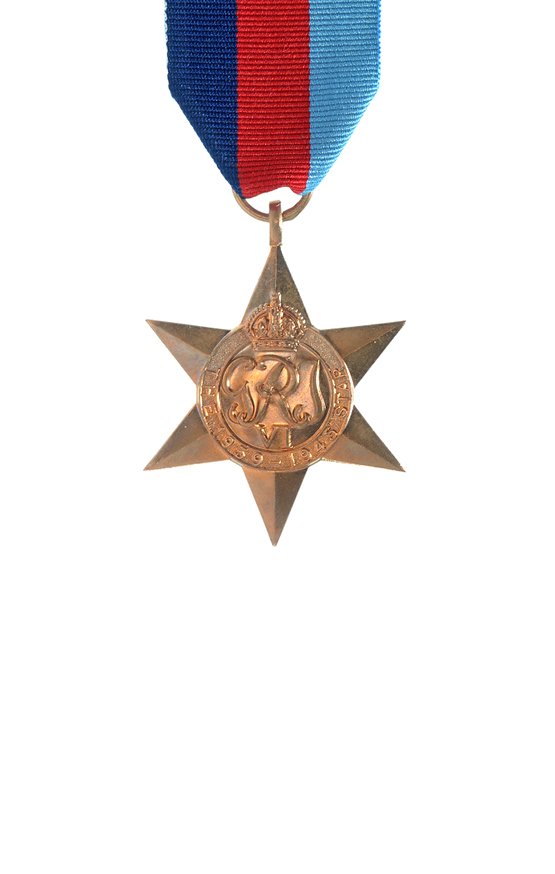
The 1939-45 Star is the first in a series of eight campaign stars instituted in 1945 to recognise service in World War Two. The ribbon has three equal vertical stripes of dark blue, red and light blue. The dark blue stripe symbolises the service of the Navy and the Merchant Navy, the red stripe symbolises the service of the Army, and the light blue stripe symbolises the service of the Air Force. The equal width bands represent the equal contributions of the three service arms towards victory. The ribbon was devised by King George VI. Two clasps could be awarded with this medal: ‘Battle of Britain’ and ‘Bomber Command’. Only aircrew would qualify for these clasps although a small number of Fleet Air Arm naval pilots flew for the air force and would be eligible for the ‘Battle of Britain’ clasp.
The Atlantic Star
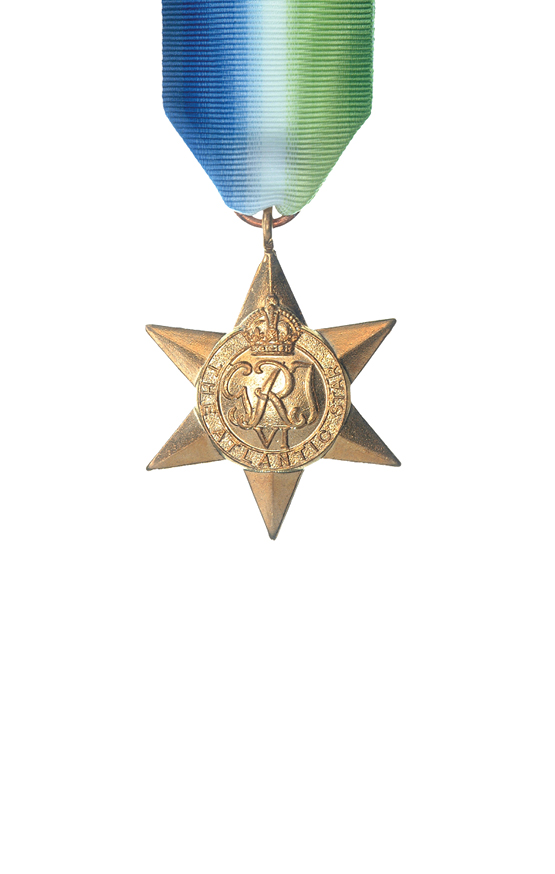
The Atlantic Star was awarded for service during the Second World War. It was instituted to commemorate the Battle of the Atlantic the longest continuous military campaign in the Second World War running from 3 September, 1939 – 8 May, 1945. Six months naval service or four months air service in the Atlantic, United Kingdom (‘home’) waters or North Russian waters was normally required. The ribbon is watered silk coloured blue, white and green, symbolising service in the oceans. Two clasps could be awarded with this medal: ‘France and Germany’ and ‘Air Crew Europe’. Personnel issued the Atlantic Star who then qualified for either the France and Germany and the Air Crew Europe Stars were awarded a clasp in respect of the second only (as only one clasp could be worn on the star).
The Pacific Star
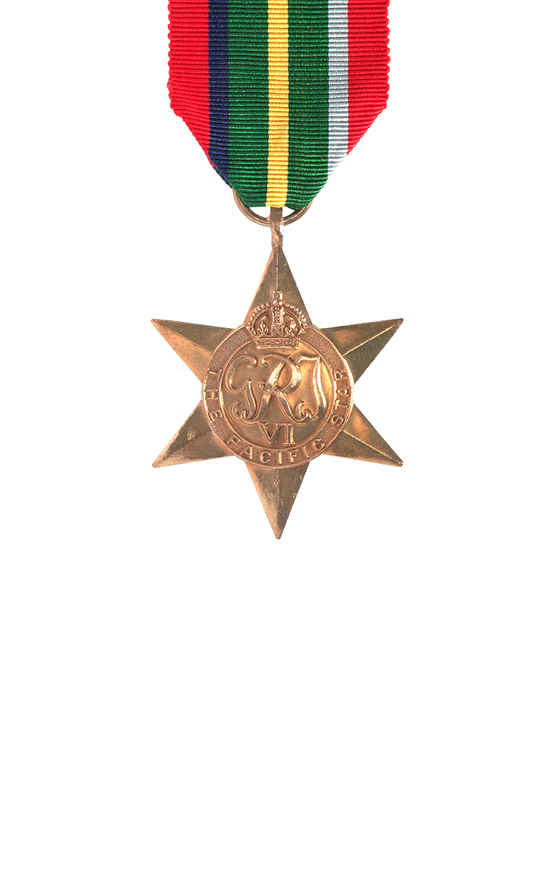
The Pacific Star was awarded in the Second World War for operational service in the Pacific between 8 December 1941 and 2 September 1945. This medal was also awarded for certain specified service in China, Hong Kong, Malaya and Sumatra: between 8 December 1941 and 25 December 1941 (for Hong Kong); between 8 December 1941 and 15 February 1942 (for China and Malaya); and between 8 December 1941 and 23 March 1942 (for Sumatra). The centre of the ribbon is dark green (symbolising the jungle) with a central yellow stripe (symbolising the beaches). On the outer edges are wide stripes of red (representing the Army), with narrow stripes of dark blue and light blue (representing the Navy and Air Force) between the stripes of dark green and red. A ‘Burma’ clasp could be awarded with this medal. Personnel qualifying for both the Pacific and Burma Stars were awarded the first star but only a clasp in respect of the second.
The War Medal 1939-1945
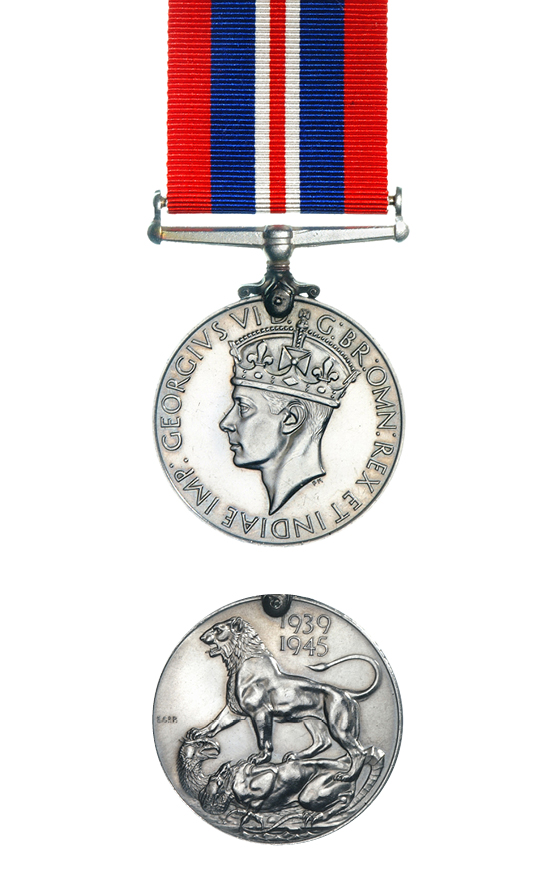
The War Medal 1939-45 was awarded across the British Commonwealth to all full-time members of the Armed Forces in the Second World War for 28 days service between 3 September 1939 and 2 September 1945, irrespective of where they were serving. The ribbon is the red, white, and blue of the (British) Union Flag. There is a narrow central red stripe with a narrow white stripe on either side. There are broad red stripes at either edge, the two intervening stripes being blue.
A bronze oak leaf on the medal ribbon denotes that the recipient was Mentioned in Despatches. To be Mentioned in Despatches a member of the armed forces had their name mentioned in an official report, written by a superior officer, and sent to a higher command. The report would describe the individual’s gallant or meritorious action in the face of the enemy.
The New Zealand War Service Medal
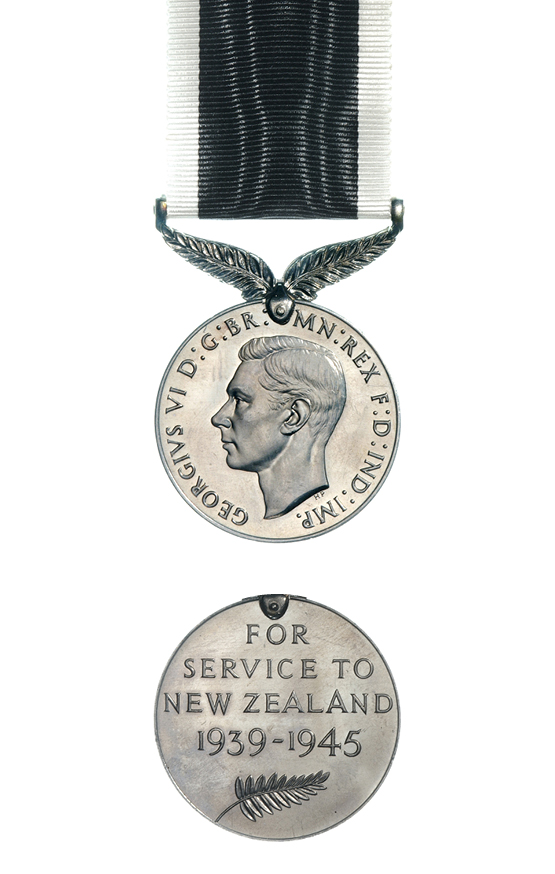
The New Zealand War Service Medal was awarded for 28 days’ full time service or six months’ part time service in the Second World War in any of the New Zealand Armed Forces including the Reserves, Naval Auxiliary Patrol Service, or Home Guard, between 3 September 1939 and 2 September 1945.
Coronation Medal 1953

This medal was issued to celebrate the coronation of Queen Elizabeth II in 1953. It was awarded to citizens of the British Commonwealth both military and civilian. Only 37 medals were issued with the names of the recipients engraved on them. These were awarded to the members of the British expedition which had reached the summit of Mount Everest on the morning of the Coronation ceremony. New Zealander, Sir Edmund Hillary, one of the two climbers who conquered the mountain, was knighted and received the Coronation Medal from the new Queen at Buckingham Palace several weeks later.

